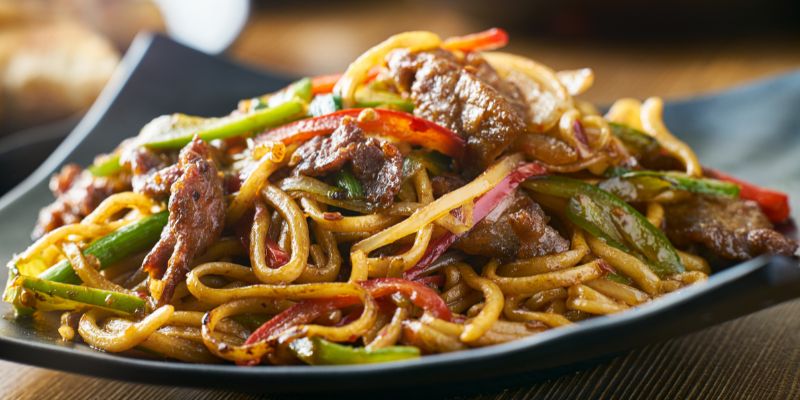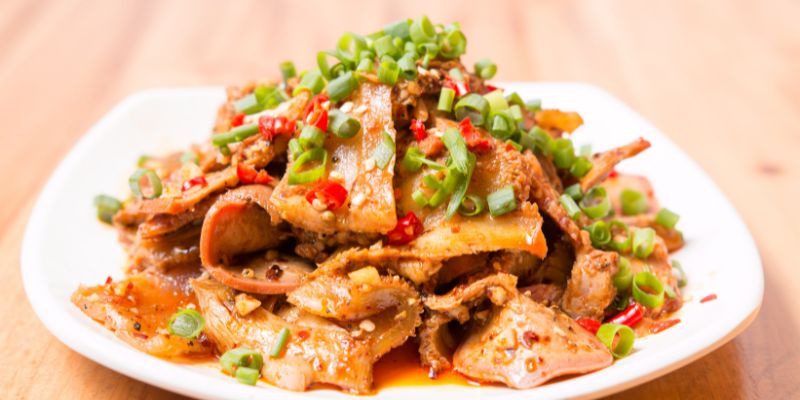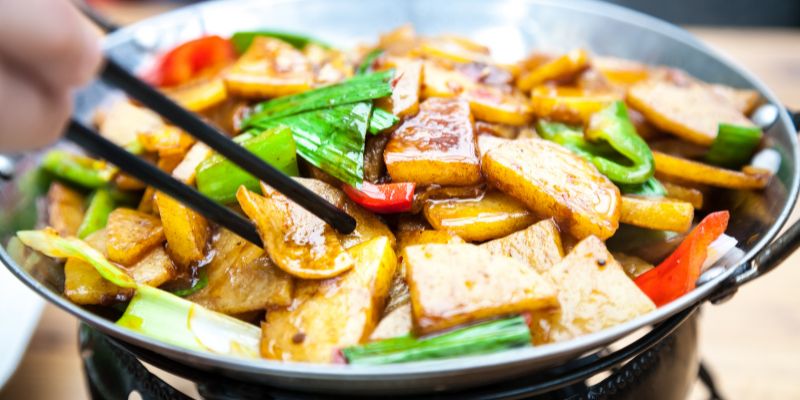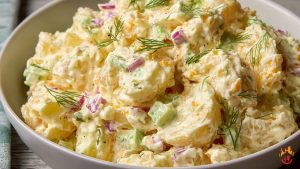Last updated on October 9th, 2023 at 03:54 pm
Chinese cuisine is renowned worldwide for its rich history, diverse flavors, and harmonious balance of ingredients. Among the plethora of culinary creations in Chinese gastronomy, the “Four Seasons Chinese Dish” stands out as a masterpiece that showcases the art of culinary balance.
In this article, we’ll delve into the amazing Four Seasons Chinese Dish! This dish is like a tasty journey through the year, blending flavors and textures. We’ll discover where it comes from, what’s in it, how it’s made, and why it’s important in Chinese cooking.
The Origins of Four Seasons Chinese Dish
To truly appreciate the Four Seasons Chinese Dish, it’s essential to understand its origins. This dish finds its roots in traditional Chinese culinary philosophy, where the balance of flavors, textures, and ingredients plays a pivotal role.
Historical Background:
The concept of Four Seasons Chinese Dish can be traced back to ancient China, where the culinary arts were highly revered. The dish was created to harmonize the ingredients available during different seasons, emphasizing the importance of freshness and seasonality in Chinese cooking.
Philosophical Underpinnings:
Chinese cuisine often draws inspiration from traditional Chinese medicine and the balance of Yin and Yang. Four Seasons Chinese Dish embodies this philosophy by combining ingredients that complement each other, both in terms of taste and nutritional properties.

The Components of Four Seasons Chinese Dish
A typical Four Seasons Chinese Dish consists of four main components, each representing a season and its unique offerings. These components are carefully picked to craft a harmonious and visually appealing presentation.
Spring:
Spring is associated with freshness and renewal. Ingredients like bamboo shoots, asparagus, and young mushrooms are commonly used in this season to evoke the vibrant spirit of springtime.
Summer:
Summer brings an abundance of vegetables and seafood to the Chinese kitchen. Bell peppers, zucchini, and prawns are often featured in the summer portion of the dish, creating a colorful and refreshing experience.
You’ll Also Like: Chinese Apple Stick: Health Benefits and Risks
Autumn:
As the temperature cools, autumn brings heartier ingredients to the table. Shiitake mushrooms, chestnuts, and duck meat are frequently included in the autumn section, providing a richer and more robust flavor profile.
Winter:
Winter is a time for warmth and comfort. Ingredients like snow peas, carrots, and beef are used in the winter component to add a satisfying and nourishing touch to the dish.

Preparing Four Seasons Chinese Dish
Creating a Four Seasons Chinese Dish requires skill and precision. Chefs carefully select, prepare, and cook each component to bring out its distinct qualities while ensuring a harmonious blend of flavors and textures.
Ingredient Selection:
The key to a successful Four Seasons Chinese Dish is choosing the freshest seasonal ingredients. Chefs pay meticulous attention to ingredient quality, ensuring that each component represents the season it embodies.
Preparation Techniques:
Different cooking techniques are employed for each component. Stir-frying, blanching, and braising are commonly used methods to highlight the natural attributes of the ingredients.
Sauce and Seasoning:
A delicate sauce is created to unite the four components. This sauce is often a combination of soy sauce, oyster sauce, and various seasonings. It enhances the overall flavor profile while maintaining the balance of the dish.
Cultural Significance

Four Seasons Chinese Dish goes beyond its culinary excellence; it holds cultural significance in Chinese society.
Celebrations and Festivals:
This dish is often featured in Chinese celebrations, particularly during the Lunar New Year, where it symbolizes prosperity and the cyclical nature of life.
Health and Balance:
In Chinese culture, balance is a fundamental concept. The Four Seasons Chinese Dish embodies this belief by incorporating ingredients that provide a balanced diet, aligning with the principles of traditional Chinese medicine.
Variations and Regional Influences
Chinese cuisine is incredibly diverse, and the Four Seasons Chinese Dish has its own regional variations. Each region adds its unique twist to this classic dish.
Cantonese Style:
Cantonese cuisine is known for its subtle flavors and emphasis on freshness. In Cantonese Four Seasons Chinese Dish, the focus is on showcasing the natural taste of the ingredients, with minimal seasoning.
Sichuan Style:
Sichuan cuisine, on the other hand, is renowned for its bold and spicy flavors. Sichuan-style Four Seasons Chinese Dish incorporates Sichuan peppercorns and chili peppers, adding a fiery kick to the dish.
Shanghai Style:
In Shanghai, the dish may feature a sweeter and more savory sauce, often incorporating elements of Shanghainese cuisine, such as soy sauce and sugar.
You’ll Also Like: Is Fried Rice Good For Weight Loss? A Nutritionist Perspect
The Experience of Dining
Eating a Four Seasons Chinese Dish is not just about satisfying your hunger; it’s a multisensory experience that engages your senses.
Visual Appeal:
The dish is presented with meticulous attention to aesthetics, with each component placed artistically on the plate. The vibrant colors and textures create an inviting visual spectacle.
Aromas:
As the dish is served, the aromas of fresh ingredients, sauces, and seasonings waft through the air, teasing your senses and building anticipation.
Taste and Texture:
With each bite, you experience a delightful contrast of flavors and textures, from the crispness of spring vegetables to the tenderness of slow-cooked meats.
Pairing and Accompaniments
Enjoying a Four Seasons Chinese Dish is not just about savoring the dish itself; it’s also about the art of pairing and accompaniments that enhance the overall dining experience.
Tea Pairing:
In Chinese culture, tea is an integral part of the dining experience. Pairing your Four Seasons Chinese Dish with the right tea can elevate the flavors. Green tea, jasmine tea, or even a light oolong tea can complement the dish’s subtleties.
Condiments:
A selection of condiments is often offered alongside the dish. These may include soy sauce, chili oil, and black vinegar. Diners can customize their sauces to their liking, adding an extra layer of personalization to their meal.
Staples and Sides:
To create a more substantial meal, Four Seasons Chinese Dish can be accompanied by staples like rice or noodles. The mild flavors of these staples serve as a perfect canvas to balance and enhance the dish’s flavors.
The Modern Interpretations
While traditional Four Seasons Chinese Dish remains a beloved classic, modern chefs are continually innovating and putting their own spin on this culinary masterpiece.
Fusion Creations:
Some chefs blend Chinese and Western culinary techniques, incorporating ingredients like foie gras, truffles, or exotic spices into the Four Seasons Dish, resulting in a fusion of flavors that appeals to adventurous palates.
Vegan and Health-Conscious Versions:
In response to evolving dietary preferences, many restaurants now offer vegan or vegetarian versions of Four Seasons Chinese Dish. Tofu, tempeh, and a medley of seasonal vegetables take center stage, offering a nutritious and cruelty-free alternative.
Interactive Dining Experiences:
Some upscale establishments have turned dining into a performance art by allowing diners to customize their Four Seasons Dish. Guests can select their preferred ingredients from a curated list, ensuring a personalized and interactive culinary adventure.
Preserving Tradition for Future Generations
As Chinese cuisine continues to change and adapt to evolving tastes, preserving the tradition of Four Seasons Chinese Dish becomes paramount.
Culinary Education:
Culinary schools in China and around the world recognize the importance of passing down traditional dishes like Four Seasons Chinese Dish to the next generation of chefs. Courses and workshops focus on the techniques and philosophy behind this iconic dish.
Cultural Heritage:
Four Seasons Chinese Dish has been recognized as an Intangible Cultural Heritage by UNESCO, highlighting its cultural significance and the need to safeguard its preparation methods and cultural context for future generations.
Home Cooking:
Encouraging home cooks to explore this culinary treasure is equally essential. Online resources, cookbooks, and cooking classes make it possible for enthusiasts to recreate the dish in their own kitchens, ensuring that the tradition lives on.
You’ll Also Like: How To Enjoy Seafood Delight Chinese Food The Right Way?
Our Take
The Four Seasons Chinese Dish is not merely a meal; it’s a gateway to a culinary world where tradition meets innovation, and nature’s bounty is celebrated. Whether you savor it in a traditional restaurant or relish its modern interpretations, this dish invites you to connect with the rich tapestry of flavors, traditions, and seasonal beauty that China has to offer.
As you indulge in this delicious masterpiece, you’re not only tantalizing your taste buds but also immersing yourself in a culinary legacy that spans generations, ensuring that the harmony of the Four Seasons lives on in each delectable bite.
Frequently Asked Questions
1. What is Four Seasons Chinese Dish, and why is it called that?
Four Seasons Chinese Dish is a culinary masterpiece in Chinese cuisine that represents the four seasons of spring, summer, autumn, and winter. It is called “Four Seasons” because it incorporates ingredients that are traditionally associated with each season, creating a dish that balances flavors, textures, and the essence of each season.
2. Are there regional variations of Four Seasons Chinese Dish, and how do they differ?
Yes, there are regional variations of Four Seasons Chinese Dish. For example, Cantonese-style emphasizes fresh ingredients with minimal seasoning, Sichuan-style adds spiciness, and Shanghai-style may have sweeter and more savory elements. Each regional variation reflects the culinary traditions and preferences of that area.
3. What are the key ingredients in a typical Four Seasons Chinese Dish?
The key ingredients in a Four Seasons Chinese Dish vary according to the season but often include vegetables like bamboo shoots, bell peppers, and snow peas, as well as proteins such as prawns, duck meat, and beef. Mushrooms like shiitake and condiments like soy sauce and oyster sauce are also commonly used.
4. Is Four Seasons Chinese Dish suitable for vegetarians or vegans?
Yes, Four Seasons Chinese Dish can be adapted to suit vegetarians and vegans. Modern interpretations often include tofu, tempeh, and a variety of seasonal vegetables to create a meat-free version of the dish that still captures the essence of each season.
5. How can I experience the Four Seasons Chinese Dish for myself?
You can experience the Four Seasons Chinese Dish by visiting Chinese restaurants that offer it on their menus. To explore its traditional preparation, you might want to dine at a reputable Chinese restaurant known for its authentic cuisine. Alternatively, you can try cooking it at home by following recipes and guidelines available in cookbooks or online resources.

At Bridge House Tavern, we’re more than a team of food enthusiasts; we’re a culinary journey waiting to be savored. Our five-member crew is on a relentless quest to explore, create, and share the wonders of the gastronomic world.



